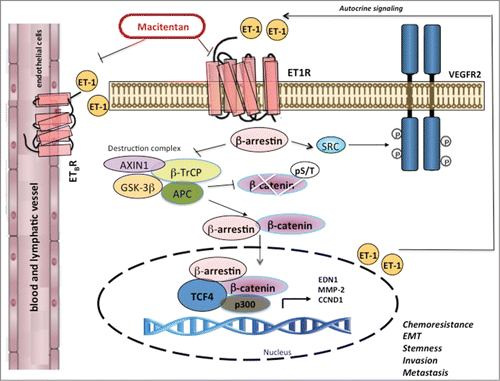Figures & data
Figure 1. Interplay between ETAR/β–arrestin-1 and Wnt/β-catenin drives chemoresistance in ovarian cancer. In chemoresistant ovarian cancer cells, binding of endothelin-1 (ET-1, EDN1) to its receptors leads to recruitment of β-arrestin-1 (ARRB1). β-arrestin inhibits the destruction complex composed of glycogen synthetase kinase 3 (GSK3), axis inhibition 1 (AXIN1), β-transducin repeat containing protein (β-TrCP), and adenomatous polyposis coli (APC), and thus promotes the accumulation of a non-Ser/Thr phosphorylated active form of β-catenin. β-arrestin-1 shuttles with β-catenin into the nucleus, where it interacts with p300 histone acetyltransferase to enhance β-catenin/T-cell-specific transcription factor-4 (TCF4)-transactivation, thus promoting the transcription of genes such as EDN1, matrix metalloproteinase 2 (MMP-2), or cyclin D1 (CCND1) and leading to enhanced chemoresistance, epithelial to mesenchymal transition (EMT), stemness, cell plasticity, invasion, and metastasis. As a signal transducer, endothelin A receptor (ETAR, EDNRA)/β-arrestin-1 initiates transactivation of the vascular endothelial growth factor receptor-2 (VEGFR-2) through SRC. In parallel, paracrine production of ET-1 activates endothelin B receptor (ETBR, EDNRB) expressed on endothelial cells, promoting expansion of vascular networks. The dual ETAR and ETBR antagonist macitentan targets not only cancer cells (which express ETAR and ETBR) but also tumor-associated stromal elements (which express ETBR).

